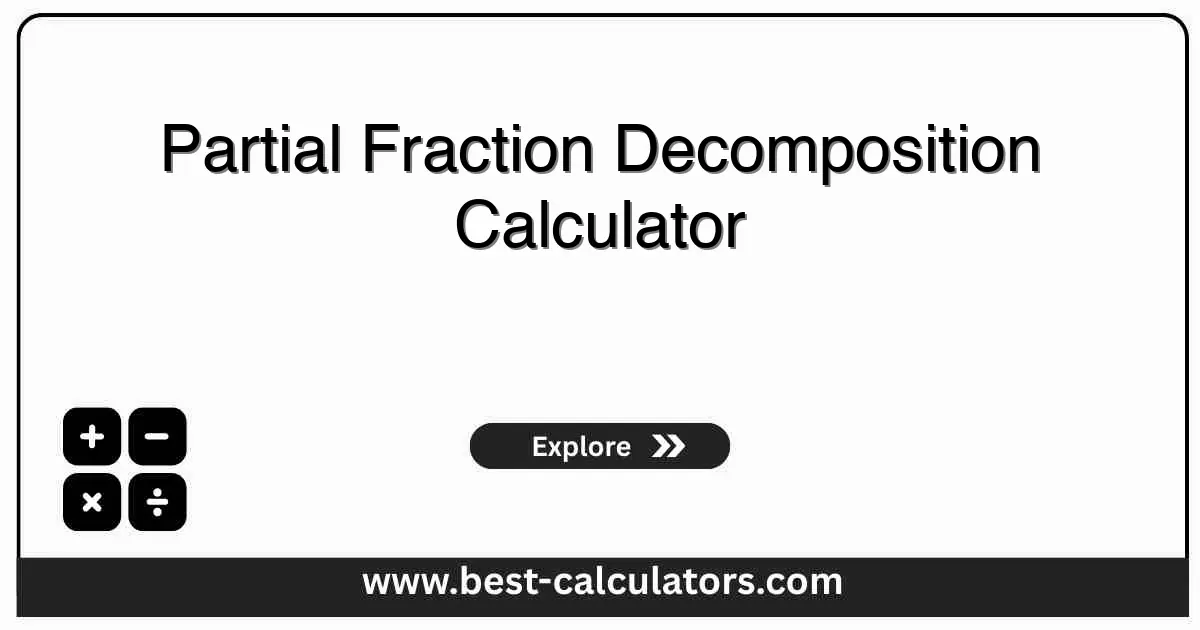Partial Fraction Decomposition Calculator
Free calculator to decompose rational expressions into partial fractions. Simplify complex fractions for integration and analysis
Partial Fraction Calculator
Decomposition
Common Examples
What is a Partial Fraction Decomposition Calculator?
A partial fraction decomposition calculator is a mathematical tool that breaks down complex rational expressions into simpler component fractions. It expresses fractions like (3x+5)/(x²-1) as sums of simpler fractions A/(x-1) + B/(x+1), making integration, analysis, and algebraic manipulation significantly easier.
Partial fractions are essential in calculus for integrating rational functions, in differential equations for solving systems, in signal processing for inverse Laplace transforms, and in control theory for transfer function analysis. Engineers, mathematicians, and scientists use this technique to simplify complex fractional expressions into manageable forms.
This calculator handles rational expressions with linear factors in the denominator, finding the coefficients A and B that make the decomposition valid. It shows the complete decomposed form and individual coefficient values, helping students verify manual work and understand the decomposition structure for different rational functions.
For polynomial operations, try our polynomial division calculator and factoring trinomials calculator. The system of equations calculator helps solve the coefficient equations. For fractions, use our fraction calculator.
How the Partial Fraction Calculator Works
The calculator takes a rational expression with factored denominator (x - r₁)(x - r₂) and decomposes it into A/(x - r₁) + B/(x - r₂). It multiplies both sides by the common denominator to eliminate fractions, creating the equation: numerator = A(x - r₂) + B(x - r₁).
By expanding and equating coefficients of like powers, the calculator creates a system of linear equations. For the x coefficient and constant term, it solves for A and B simultaneously. Substituting specific values of x that zero out factors provides an alternative method called the cover-up rule.
The calculator verifies results by expanding A/(x - r₁) + B/(x - r₂) back to a single fraction and confirming it matches the original expression. This ensures the decomposition is correct and helps students understand that partial fractions and combining fractions are inverse operations.
Key Concepts Explained
Rational Expression
A fraction with polynomials in numerator and denominator. Partial fractions decompose these into simpler component fractions easier to integrate or manipulate.
Proper Fraction
Numerator degree less than denominator degree. If improper, perform polynomial division first before decomposing the remainder fraction.
Linear Factors
Factors of form (x - a). Each distinct linear factor contributes one term A/(x - a) to the decomposition with constant numerator A.
Cover-Up Rule
Quick method to find coefficients by substituting values that zero out denominators. Particularly efficient for distinct linear factors.
How to Use This Calculator
Enter Numerator
Input coefficients of numerator polynomial in form ax + b. Enter coefficient of x and constant term
Enter Roots
Input the roots r₁ and r₂ where denominator factors as (x - r₁)(x - r₂)
Decompose
Click Decompose to get partial fraction form with coefficients A and B calculated
View Decomposition
See complete partial fraction form and individual coefficient values instantly
Benefits of Using This Calculator
Using this partial fraction calculator eliminates errors in solving systems of equations for coefficients and streamlines the decomposition process significantly.
Instant Decomposition: Get partial fractions immediately instead of solving coefficient equations manually
Simplify Integration: Convert complex rational functions into simpler forms for easier integration
Verify Solutions: Check your manual partial fraction decomposition work for accuracy
Learn Structure: Understand how coefficients relate to numerator and denominator structure
Save Time: Avoid tedious algebraic manipulations in multi-step decomposition process
Factors That Affect Your Results
The numerator coefficients and denominator roots completely determine the partial fraction coefficients. Understanding these relationships helps predict decomposition form.
Numerator Degree
Must be less than denominator degree for proper fraction. If numerator degree equals or exceeds denominator, perform polynomial division first.
Distinct Factors
Each distinct linear factor (x - r) gets one term in decomposition. Two distinct factors produce two terms A/(x - r₁) + B/(x - r₂).
Coefficient Uniqueness
For given rational expression with distinct linear factors, partial fraction coefficients are unique. Different numerators produce different coefficients.

Frequently Asked Questions (FAQ)
Q: What is partial fraction decomposition?
A: Partial fraction decomposition is the process of breaking down a complex rational expression into a sum of simpler fractions. For example, (3x+5)/(x²-1) decomposes into A/(x-1) + B/(x+1). This simplifies integration and analysis of rational functions.
Q: When do you use partial fraction decomposition?
A: Use partial fractions when integrating rational functions, solving differential equations, finding inverse Laplace transforms, and simplifying complex fractions. The denominator must be factored before decomposition.
Q: What if the degree of numerator is higher?
A: If numerator degree equals or exceeds denominator degree, first perform polynomial long division. Then decompose only the remainder fraction. This gives quotient plus partial fractions.
Q: How do you handle repeated factors?
A: Repeated linear factors (x-a)ⁿ require n terms: A₁/(x-a) + A₂/(x-a)² + ... + Aₙ/(x-a)ⁿ. Each power from 1 to n gets its own term with separate coefficient.
Q: What about irreducible quadratic factors?
A: Irreducible quadratic factors (ax²+bx+c) that cannot be factored require numerators of form Ax+B. For example, (Ax+B)/(x²+1) where both A and B are constants to be determined.